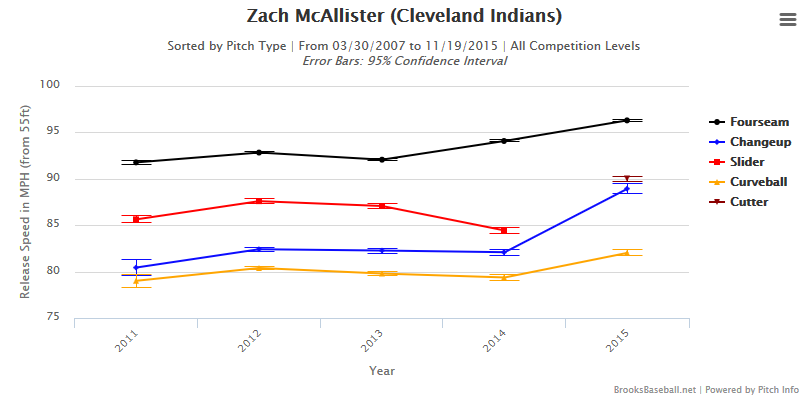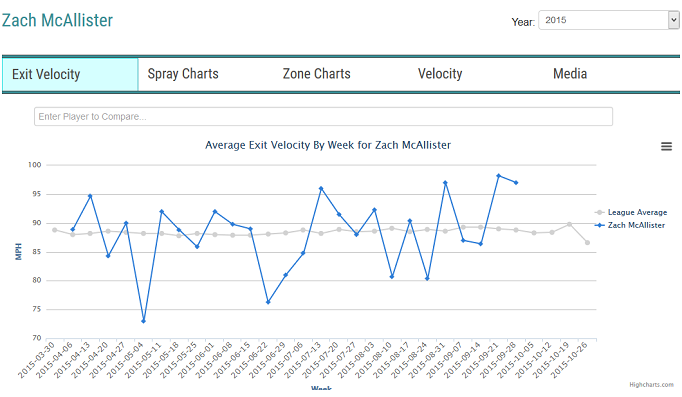While we’re all waiting for Gabe Kapler or Dave Roberts to be named manager (hopefully soon … this is dragging on), offseason moves await.
Mike wrote about the Dodgers potentially landing a starting pitcher in a place other than the free agent market (and I agree with him) and cited one of the Cleveland starters or a guy like Shelby Miller from Atlanta. While landing a guy like Carlos Carrasco, Danny Salazar or Corey Kluber (yeah, I don’t see it either) would cost Yasiel Puig or other valuable assets, the Dodgers have needs outside the rotation. Luckily, one of those needs could be filled via Cleveland — perhaps in a package deal for one of their starters.
Cody Allen is the obvious target. And why not? He’s one of baseball’s best relievers. The 27-year-old (today) led all relievers in WAR (2.6) and FIP (1.82) and posted a 12.8 strikeouts per nine innings rate. Seeing as Craig Kimbrel just netted the Padres quite the haul, Cleveland could choose to sell high on Allen. Also, he’s projected to make $3.5 million via the arbitration process as a first-timer. He’s going to cost a lot. So, an alternative could be his teammate who was in the Cleveland rotation just a season ago: Zach McAllister.
I can’t take full credit for this idea. Mike brought it up in the comments on Thursday and I was completely out of the loop on McAllister. After looking at his numbers, he might be just the kind of guy the Dodgers need to add this winter for the bullpen.
McAllister, 27, moved to the bullpen full-time this season (he made one start on April 10 and made his next 60 appearances out of the bullpen. In that role, he saw everything move in the right direction. He established career-bests in ERA (3.00), FIP (3.15), xFIP (3.26), K/9 (10.9), K% (28.1), LOB% (78.6), GB% (43.3) and swinging strike rate (9.8 percent). As what happens often times when starters move to the bullpen, he saw an increase in his velocity.
 It was a pretty significant increase, too. His fastball increased 2 MPH, but the biggest increase came in his changeup (from 82.1 to 88.9 MPH). He even threw his curveball in the low-80s. He ditched his slider and added a cutter (which is likely just a variation on his slider).
It was a pretty significant increase, too. His fastball increased 2 MPH, but the biggest increase came in his changeup (from 82.1 to 88.9 MPH). He even threw his curveball in the low-80s. He ditched his slider and added a cutter (which is likely just a variation on his slider).
He was always a 70-percent-plus fastball pitcher, but the biggest difference in the move to the bullpen is he got more swings and misses on it. In 2014, he had a whiff rate of 8 percent on his fastball. It jumped to 13 percent in 2015. That, coupled with a 10.7 percent whiff rate on his cutter and suddenly, you have a more than competent reliever. He’s no Kelney Jansen when it comes to whiff rate, but he obviously misses enough bats.
It isn’t like he was a bad starting pitcher, either. He was worth nearly 1.5 wins from 2012 through 2014. His biggest problem was pitching deep into games. He averaged just 115 innings per season, with his career-high in innings was 134 1/3. But Cleveland has enough rotation depth to make a move like this to strengthen the league’s sixth-best bullpen by WAR and fourth-best by ERA. And it looks like the bullpen is best for him. From the Let’s Go Tribe blog on SB Nation.
“When he did come out of the bullpen, McAllister’s role was primarily middle relief to eat up an inning, or eat up two innings if the starting pitcher struggled on the day. Other than his first relief appearance on April 14 against the Chicago White Sox, McAllister was never left in the game for more than two innings. Not to keep repeating myself, but again, this ensured that he would never face the lineup more than once. If you take out that one disastrous start, McAllister’s year looks even better. “
The standard operating procedure for McAllister seems to be limiting the number of times he goes through the lineup, hence his struggles as a starter. While some think he could follow in Carrasco’s footsteps and end up back in the rotation, I’m betting he doesn’t.
His fly ball profile fits well in Dodger Stadium. His walk rate leaves a little to be desired (3.0 BB/9). Also, his .346 BABIP could normalize and lead to more success going forward — especially since his exit velocity numbers are encouraging.
 He, like Allen, is entering his first year of arbitration and is slated to make $1 million. His inclusion in a package deal for a Cleveland starter seems like a no-brainer from the Dodgers’ end. It just needs to be worth it for Cleveland, too. If the Dodgers somehow add him and Darren O’Day, a guy everyone is convinced will sign with LA, the bullpen is looking a lot better already.
He, like Allen, is entering his first year of arbitration and is slated to make $1 million. His inclusion in a package deal for a Cleveland starter seems like a no-brainer from the Dodgers’ end. It just needs to be worth it for Cleveland, too. If the Dodgers somehow add him and Darren O’Day, a guy everyone is convinced will sign with LA, the bullpen is looking a lot better already.
 Dodgers Digest Los Angeles Dodgers Baseball Blog
Dodgers Digest Los Angeles Dodgers Baseball Blog